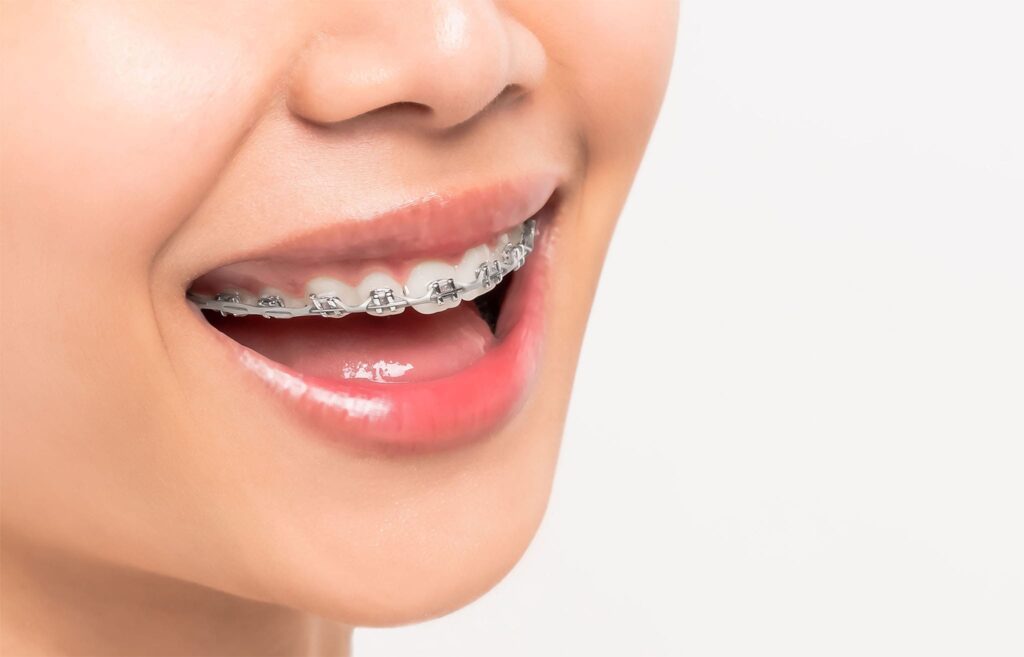
Teeth straightening with braces
An improper bite, or malocclusion, in children and adults is a common dental problem. Any issues with the dentoalveolar system are not only detrimental to your aesthetic but can lead to further, generalised problems. Therefore, it is important that you have any bite defects diagnosed and corrected professionally by an orthodontist. Modern orthodontics can offer a wide range of effective solutions for patients of all ages. One of the most common and effective treatments for malocclusion is the use of braces.
- What are the requirements for straightening teeth with braces?
- Stages of straightening teeth with braces
- Types of braces
- What are the consequences of an irregular bite?
- What are the age restrictions for straightening teeth with braces?
- Duration of teeth straightening with braces
- Is the brace installation procedure/wearing painful?
- Oral hygiene with braces
- How often are visits to the clinic required when wearing braces?
- Orthodontic implants
- What are the differences between straightening teeth with braces and aligners?
- After removal of braces
- Frequently asked questions
- Pricelist
What are the requirements for straightening teeth with braces?
Braces are complex and non-removable orthodontic systems that are installed in the patient’s mouth in order to correct malocclusion and tooth misplacement. The main pathologies that indicate the need for braces are the following:
- Upper dental protrusion
The upper front teeth are inclined forward.
- Displacement of one or both midlines of the jaws
Normally the midline of the jaw should coincide with the midline of the face.
- Teeth crowding
Reduced gaps between teeth, abnormal teeth positioning. In severe cases, one tooth may overlap another.
- Trema, diastema
Large gaps between teeth.
- Open bite
The upper and lower jaws do not make contact when closed, leaving a gap between them. This abnormality can occur in both the front teeth and molars.
- Deep bite
The upper teeth cover the lower teeth more than usual. In severe cases, the lower teeth may touch the palate.
- Distal occlusion
An excessive forward displacement of the upper jaw.
- Mesial occlusion
The teeth of the lower jaw are noticeably inclined to the front.
- Crossbite
The teeth are facing different directions: in one area of the jaw, the upper teeth protrude forward, in the other – the lower teeth. The upper and lower teeth in this case touch each other irregularly or do not come in contact at all.
- Transposition
When the teeth are displaced from their normal germination sites.
- Rotation
Anomalous rotation of one or more teeth along their centre.
Misplacement of teeth and malocclusion cause far more problems than just visual. Bite pathologies can, in many cases, lead to excessive salivation, tooth loss, headaches, sinusitis, diseases of the mouth and digestive system, as well as speech and psychological disorders. It is important that we diagnose bite pathologies in a timely manner so we can eliminate, or reduce, any unpleasant consequences through the use of orthodontic treatment.
The specialists in our clinic are always ready to provide consultation for bite disorders, create the most effective treatment plan, and correct even the most serious occlusal problems.
Stages of straightening teeth with braces
1 – Initial consultation and creation of a treatment plan
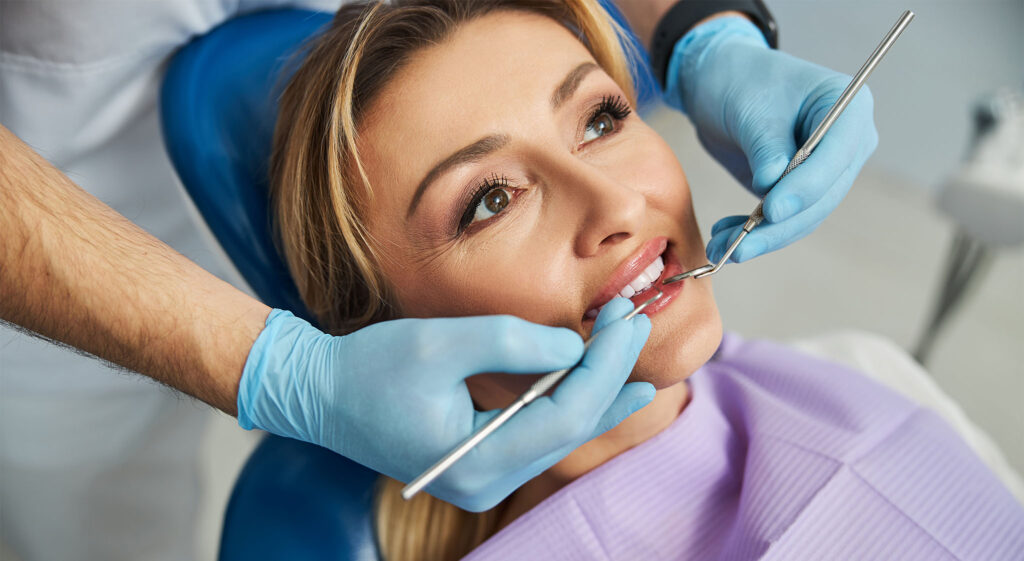
During the initial consultation, the orthodontist makes a preliminary diagnosis by assessing the patient’s occlusion as well as the condition of dental muscles, joints, and teeth. To confirm the diagnosis, the patient undergoes a dental X-ray examination though, if required, other dental diagnostic methods shall be used. The doctor uses the scans of the patient’s mouth to produce a digital 3d model that is used for diagnostics and treatment planning. Based on the results of the diagnostic tests, a personalised treatment plan is devised.
2 – Preparation for orthodontic treatment
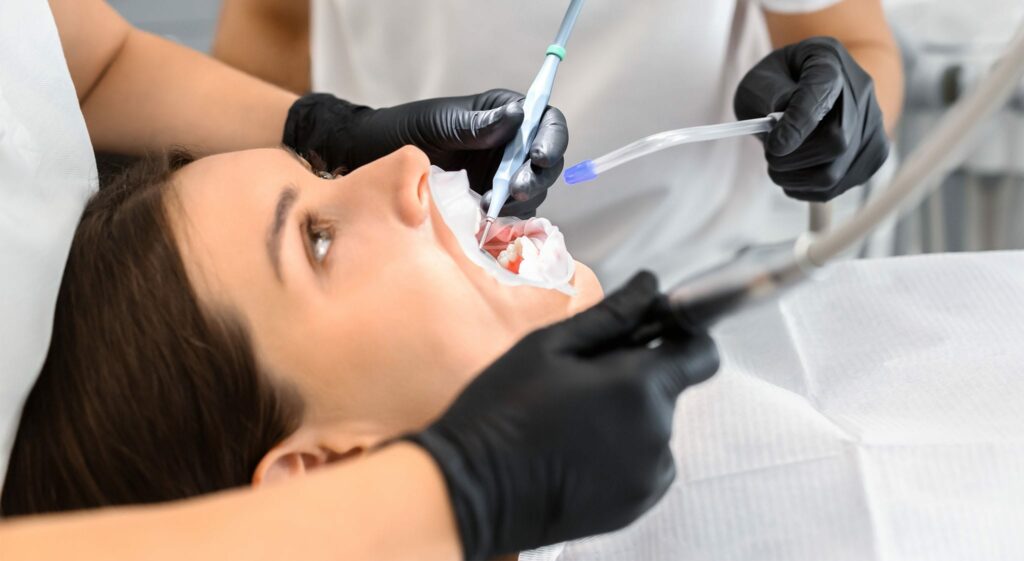
Dental plaque and tartar attract bacteria that can lead to gum disease and inflammation over time. Therefore, a professional oral hygiene cleaning session is performed before starting the orthodontic treatment with braces.
Additionally, all dental treatment procedures must be performed before the braces are installed as any inflammation or damage can cause the procedure to fail. These may include filling of damaged teeth, root canal treatments, renewal of worn fillings, dental prosthetics, etc.
3 – Installation of braces
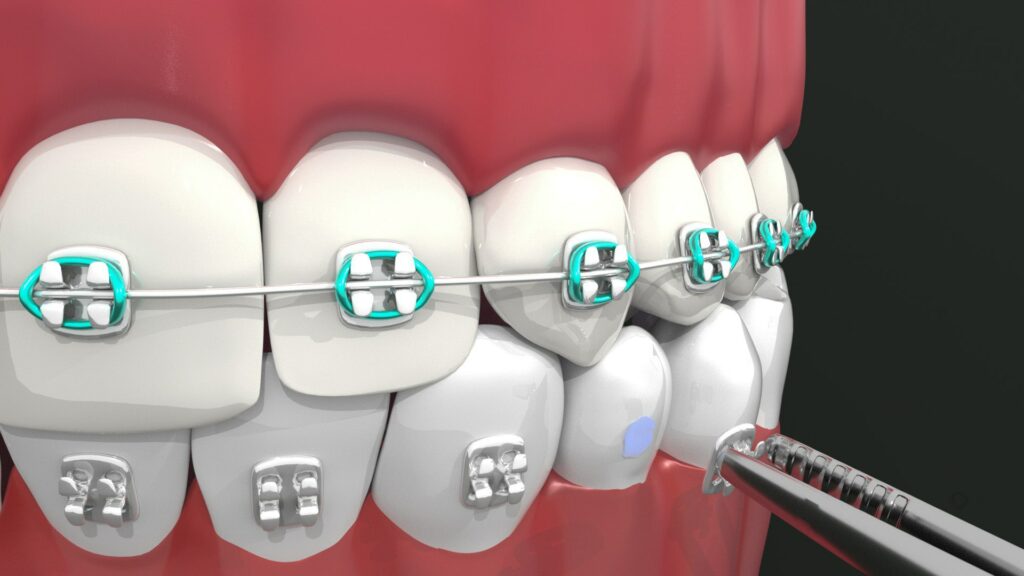
Installing braces typically takes 1.5 to 2 hours though the duration of the procedure depends on the type of braces, as well as the patient’s level of malocclusion. The installation is performed according to a standard procedure protocol consisting of five main steps:
- Cleaning and polishing of teeth. Before the procedure, the orthodontist covers the patient’s lips with an emollient gel, to help moisturise and protect the lips, and attaches lip and jaw retractors. In order to ensure good adherence of the braces, the surfaces of the teeth are thoroughly cleaned and polished with our specialised dental polishing tools and pastes.
- Coating the teeth with protective gel. The cleaned and polished teeth are dried and covered with a micronutrient-enriched protective gel that fills the invisible micro-cracks in the enamel, which helps to strengthen it and protect it from decay.
- Installation of the braces. This stage requires a high level of precision and therefore lasts the longest. Braces are attached individually to each tooth using special glue. This stage of the procedure is particularly important because the distribution of the traction power of the orthodontic system depends on the accuracy of the location of each individual bracket.
- Installation of the archwire. The braces are connected into a single system using a special archwire. The orthodontist creates the right traction force for the displacement of the teeth. It is possible to fix the direction of traction of each bracket individually to achieve lateral or vertical correction of the respective tooth.
4 – Treatment process
As soon as the braces are installed they are „activated“, meaning correction begins immediately after the procedure. The first results start showing after about 2-4 weeks. As the teeth move towards their correct position the initial pressure of the braces becomes insufficient. Therefore, it is important that you visit the orthodontist regularly during the treatment to adjust the braces and ensure the success of the treatment. The adjustment procedure consists of an inspection, documentation of the results, and retrofitting or updating of any required orthodontic components to ensure constant traction.
5 – Retention period
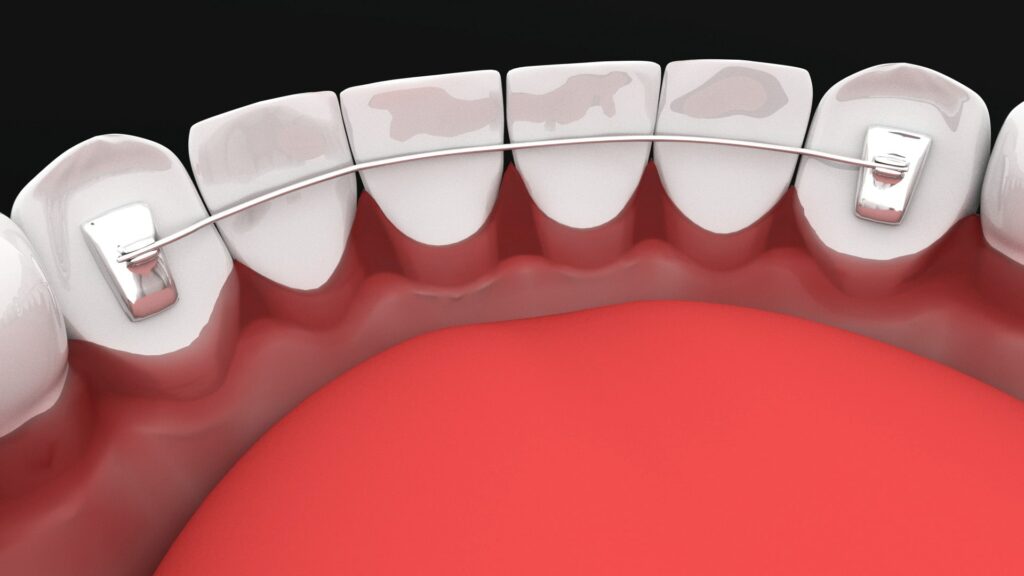
The retention period is the last but most important stage of orthodontic treatment. The retention period requires special attention as, after the removal of the braces, the pulling force disappears and the teeth may move back to their incorrect positions again. A special fixator called a retainer is installed to maintain the result of the bite correction.
Retainers can be removable and non-removable. Removable holders are orthodontic aligners that are manufactured specifically for each patient. A non-removable holder is a metal wire attached to the inside of the teeth using a photopolymer material. The use of these holders ensures that the orthodontic result is maintained.
The duration of use of the retention period is determined by the recommendations of the orthodontist.
Types of braces
When performing orthodontic treatment in our clinic, you can choose from the most popular and effective types of braces:
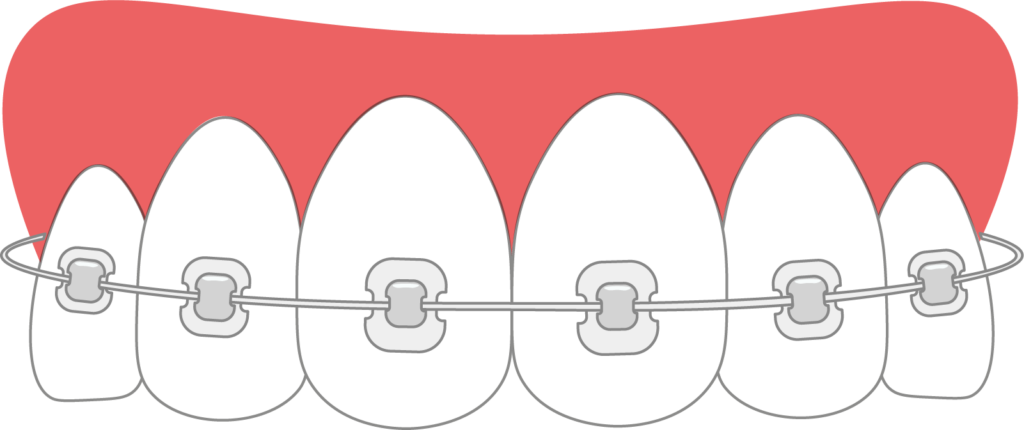
Metal braces
Standard metal alloy units. Their advantages include affordability, strength, and efficacy in the treatment of any occlusal pathology. However, not all patients like the appearance of metal braces. Metal braces are often the preferred solution for patients over 20 years of age or for patients with a complex bite defect.
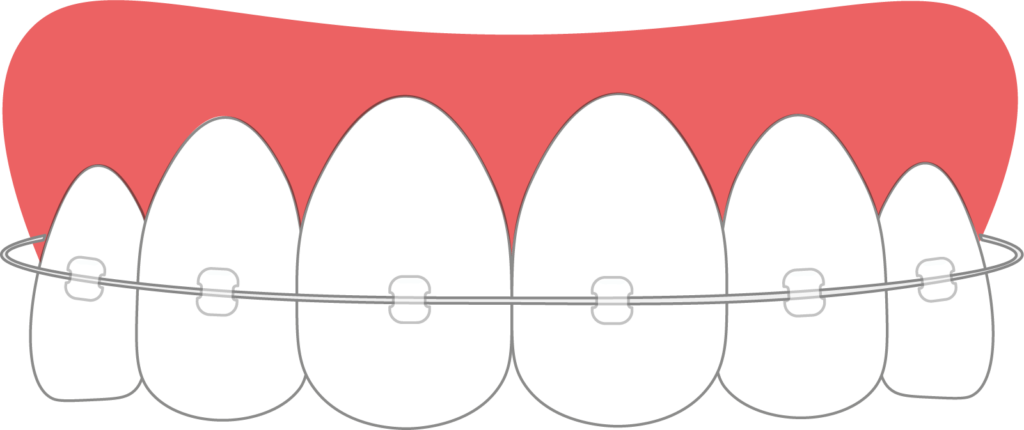
Self-ligating braces
Self-ligating braces are similar to metal in their appearance but have self-tightening properties. One of the main features of self-ligating braces is that, due to the construction of the brackets, the archwire remains mobile. For this reason, it fastens as the position of the teeth changes, which ensures constant traction. The frictional force applied to the tooth surface is also reduced.
The self-ligating braces have the following advantages:
- The flexibility of the archwire reduces pain and tooth pressure.
- The system is more compact and makes oral hygiene easier.
- In most cases, the design of the ligature braces ensures faster treatment.
- Less frequent visits to an orthodontist during treatment.
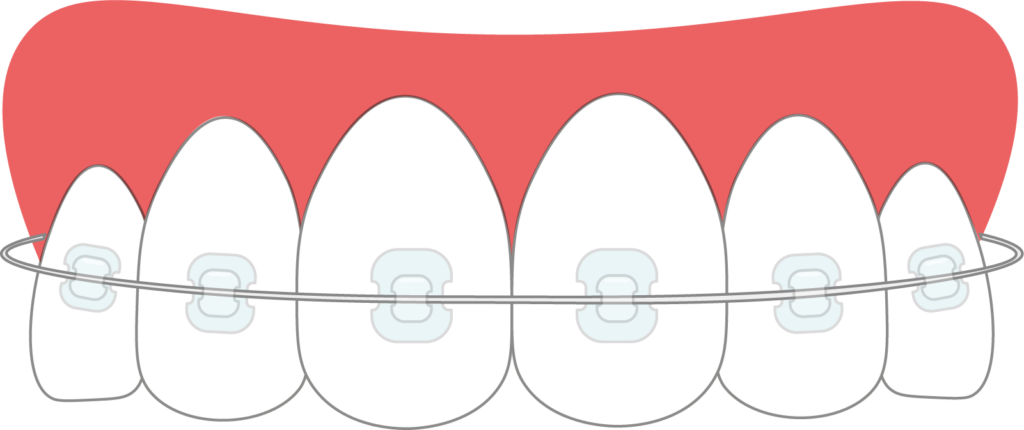
Sapphire braces
Sapphire braces have the highest visual appeal, making them the optimal solution for patients who care most about the appearance of their smile. Such braces are transparent and do not go well with the light natural colour of the teeth. Sapphire braces are securely fixed and only require a short adjustment period of no more than 2-3 weeks.
What are the consequences of an irregular bite?
A bite defect can cause serious health problems such as:
- Diseases of the teeth and gums.
- Tooth loss.
- Excessive salivation.
- Psychological disorders associated with facial and jaw aesthetic problems and difficulty speaking.
- Headaches.
- Sinusitis.
- Digestive system dysfunction.
Straightening of the teeth using braces is a popular, widely used method of bite correction. It is very important that we diagnose malocclusion as early as possible and that you have orthodontic treatment with a qualified specialist.
What are the age restrictions for straightening teeth with braces?
Malocclusions and tooth placement defects can be corrected in both adults and children. However, premature installation of braces is not recommended by orthodontists as it can lead to the resorption of underdeveloped roots and the loss of teeth in the future.
Since everyone’s teeth grow differently, a very important step in their straightening is the initial consultation with an orthodontist. The optimal age for braces installation is around 12 to 13 years (a period of intensive occlusion formation). However, it depends on the individual’s rate of development of their jaw, and the condition of their teeth and gums. Personalised advice on orthodontic treatment is given by a specialist during the oral inspection.
Duration of teeth straightening with braces
The duration of treatment with braces depends on the complexity of the clinical case, the patient’s age, health, and the type of orthodontic system used. The average period of orthodontic treatment with braces varies from 1 to 3 years. The expected duration of the preliminary treatment is given by the orthodontist before the treatment.
Is the brace installation procedure/wearing painful?
The process of installation can be a bit tedious but is completely painless, though it is likely to cause some discomfort. The discomfort is caused by the unpleasant sensation of a foreign body in the mouth, toothache, and the rubbing of the mucosa of the cheeks against the rear braces and archwire ends. It usually takes 1-2 weeks to get used to wearing braces.
After the braces are installed or adjusted, the teeth begin to move under the pulling force which, in many cases causes minor pain though stronger pain may be felt in the first couple of days after the installation/adjustment. Therefore, we recommend that you do not eat any harder foods that require a strong biting force while the pain is felt. Analgesics (paracetamol, ibuprofen, etc.) and special analgesic mouthwashes can also be used to neutralise the pain.
Oral hygiene with braces
It is important that you take care of your braces by brushing your teeth thoroughly and regularly at home and by visiting an oral hygienist more frequently than usual (every 3-4 months) for a professional oral hygiene appointment. Only specialist equipment allows you to completely clean the tartar and plaque that accumulates in hard-to-reach places and ensure proper protection of teeth and gums.
To prevent dental and oral diseases, it is recommended that you follow several rules for oral care:
- Brushing your teeth in the morning and evening.
- Rinsing your mouth after each meal.
- Cleaning interdental spaces regularly with orthodontic floss.
- Following the diet recommended by the orthodontist.
- In addition to the usual set of oral hygiene products, you should get a single tufted toothbrush, which will allow you to clean the narrow and hard-to-reach gaps. There is also a special orthodontic brush with V-shaped bristles that should be used instead of the usual dental care brush. It is recommended that you replace brushes regularly.
Detailed instructions for personal oral care are provided by the treating orthodontist.
How often are visits to the clinic required when wearing braces?
After braces are installed, the average frequency of visits to an orthodontist is once every 2 months. This is necessary so we can monitor the treatment and adjust the braces as required. Self-ligating braces can reduce the frequency of visits to the orthodontist because their design does require fixation of the archwire or additional elastic bands. The required frequency of clinic visits is determined during the consultation with the orthodontist.
Orthodontic implants
Treatment with braces works due to the pulling forces generated by the orthodontic elements, with the forces being determined by fixing the archwire at specific points along with the patient’s teeth. However, orthodontists often face the need to adjust a single tooth without changing the position of the adjacent teeth. To reduce the risk of adverse effects on healthy teeth, orthodontists will use orthodontic implants, that are 6-12 mm long screws made of titanium or its alloy which act as anchors to move only the required teeth.
Orthodontic implants have a smooth surface, do not fuse with the bone, and are easily removed at the end of orthodontic treatment without any permanent damage. Orthodontic implants are used in treatment with braces and help to:
- Significantly speed up the treatment process.
- Achieve more accurate and predictable treatment results
- Prevent delay as they are suitable to be used in the orthodontic system immediately after installation.
- Provide the ability to correct the most severe bite defects while maintaining healthy teeth.
What are the differences between straightening teeth with braces and aligners?
Both orthodontic systems are very similar in their principle but their design, use, and cost of treatment differ
Straightening with braces
Advantages
- Optimal price
- High efficiency
- Suitable for severe bite defects
Disadvantages
- Aesthetically worse
- Difficult oral hygiene care
- The need to follow a certain orthodontic diet
Straightening with aligners
Advantages
- Visually appealing
- Convenient
- Design mobility
- Easy maintenance
- Easier oral hygiene care
Disadvantages
- Higher cost compared to braces
- High dependency on patient’s self-discipline
- Cannot be used in severe clinical cases
After removal of braces
Immediately after removing the braces, the teeth may look imperfect as prolonged usage of braces can cause plaque and tartar to accumulate in hard-to-reach areas. In order to eliminate the consequences of using braces, and to prepare the teeth for further treatment, it is recommended that you receive a professional oral hygiene session and tooth fluoridation. It is also recommended that we do not perform any preventive procedures earlier than one week after the removal of the braces. If decay or other diseases of the teeth and gums are detected, further dental treatment may be required.
In addition, the orthodontic treatment is not completed after the removal of the braces. The removal of the system is followed by the retention period, during which result of the orthodontic correction is consolidated using retainers. The duration of the retention period is determined by the orthodontist performing the treatment.
Frequently asked questions
Pricelist
Adults
| Initial orthodontist consultation | 50 € |
| Future orthodontist consultations | 15 € |
| Installation of a retainer | 110 € |
| Installation of sapphire braces (1 arch) | 995 € |
| Installation of self-ligating braces (1 arch) | 960 € |
| Installation of metal braces (1 arch) | 600 € |
| Reinstallation of a metal bracket | 35 € |
| Installation of a sapphire bracket | 60 € |
| Installation of a self-ligating bracket | 60 € |
| Removal of metal braces (1 arch) | 70 € |
| Removal of sapphire braces (1 arch) | 95 € |
| Button placement | 25 € |
| Plate correction, activation Ⅰ | 25 € |
| Plate correction, activation Ⅱ | 35 € |
| Diagnostic models | 25 € |
| Regular orthodontic plate | 195 € |
| Orthodontic plate with additional elements | 225 € |
| Functional appliance | 300 € |
| Metal braces activation changing the archwire; 1 arch | 50 € |
| Metal braces activation without changing the archwire; 1 arch | 30 € |
| Metal braces activation changing the archwire; both arches | 85 € |
| Metal braces activation without changing the archwire; both arches | 50 € |
| Sapphire braces activation changing the archwire; 1 arch | 65 € |
| Sapphire braces activation without changing the archwire; 1 arch | 35 € |
| Sapphire braces activation changing the archwire; both arches | 110 € |
| Sapphire braces activation without changing the archwire; both arches | 60 € |
| Distalization appliance | 505 € |
| Class II corrector | 360 € |
| Orthodontic trainer | 135 € |
| Retention plate | 135 € |
| Retention aligner | 110 € |
| Additional orthodontic materials (elastics, hooks, etc.) | 10 € |
Children
| Orthodontist consultation | 40 € |
